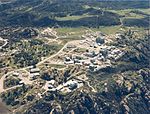Santa Susana Field Laboratory

The Santa Susana Field Laboratory (SSFL), formerly known as Rocketdyne, is a complex of industrial research and development facilities located on a 2,668-acre (1,080 ha) portion of Southern California in an unincorporated area of Ventura County in the Simi Hills between Simi Valley and Los Angeles. The site is located approximately 18 miles (29 km) northwest of Hollywood and approximately 30 miles (48 km) northwest of Downtown Los Angeles. Sage Ranch Park is adjacent on part of the northern boundary and the community of Bell Canyon is along the entire southern boundary.SSFL was used mainly for the development and testing of liquid-propellant rocket engines for the United States space program from 1949 to 2006, nuclear reactors from 1953 to 1980 and the operation of a U.S. government-sponsored liquid metals research center from 1966 to 1998. Throughout the years, about ten low-power nuclear reactors operated at SSFL, (including the Sodium Reactor Experiment, the first reactor in the United States to generate electrical power for a commercial grid, and the first commercial power plant in the world to experience a partial core meltdown) in addition to several "critical facilities" that helped develop nuclear science and applications. At least four of the ten nuclear reactors had accidents during their operation. The reactors located on the grounds of SSFL were considered experimental, and therefore had no containment structures. The site ceased research and development operations in 2006. The years of rocket testing, nuclear reactor testing, and liquid metal research have left the site "significantly contaminated". Environmental cleanup is ongoing. The public who live near the site have strongly urged a thorough cleanup of the site, citing cases of long term illnesses, including cancer cases at rates they claim are higher than normal. On 30 March 2018, a seven-year-old girl living in Simi Valley died of neuroblastoma, prompting public urging to thoroughly clean up the site. Experts have said, however, that there is insufficient evidence to identify an explicit link between cancer rates and radioactive contamination in the area.
Excerpt from the Wikipedia article Santa Susana Field Laboratory (License: CC BY-SA 3.0, Authors, Images).Santa Susana Field Laboratory
Arness Fire Road,
Geographical coordinates (GPS) Address Nearby Places Show on map
Geographical coordinates (GPS)
| Latitude | Longitude |
|---|---|
| N 34.230822 ° | E -118.696375 ° |
Address
Rocketdyne Santa Susana Field Lab
Arness Fire Road
93064
California, United States
Open on Google Maps







